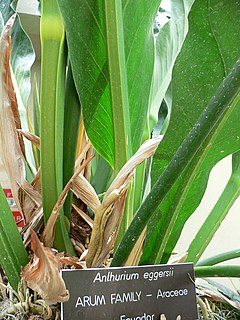
Aiphanes is a genus of spiny palms which is native to tropical regions of South and Central America and the Caribbean. There are about 26 species in the genus, ranging in size from understorey shrubs with subterranean stems to subcanopy trees as tall as 20 metres (66 ft). Most have pinnately compound leaves ; one species has entire leaves. Stems, leaves and sometimes even the fruit are covered with spines. Plants flower repeatedly over the course of their lifespan and have separate male and female flowers, although these are borne together on the same inflorescence. Although records of pollinators are limited, most species appear to be pollinated by insects. The fruit are eaten by several birds and mammals, including at least two species of amazon parrots.
Erythrina eggersii is a vine or tree in the family Fabaceae which is commonly known as cock's-spur, espuelo de gallo, or pinon espinoso. It is native to Puerto Rico, the British Virgin Islands and the U.S. Virgin Islands, where it is threatened by the act of habitat loss.
Baccharis eggersii is a species of flowering plant in the aster family that is endemic to Ecuador. Its natural habitat is subtropical or tropical dry forests. It is threatened by habitat loss. It may occur in Churute Mangroves Ecological Reserve and Machalilla National Park.
Critonia eggersii is a species of flowering plant in the family Asteraceae. It is found endemic to Ecuador. Its natural habitat is subtropical or tropical moist lowland forests. It is threatened by habitat loss.
Lycoseris eggersii is a species of flowering plant in the family Asteraceae. It is found only in Ecuador. Its natural habitats are subtropical or tropical moist lowland forests and subtropical or tropical moist montane forests. It is threatened by habitat loss.
Acalypha eggersii is a species of plant in the family Euphorbiaceae. It is endemic to Ecuador. Its natural habitat is subtropical or tropical dry forests.

Anthurium eggersii is a species of plant in the family Araceae. It is endemic to Ecuador. Its natural habitat is subtropical or tropical moist lowland forests. It is threatened by habitat loss.
Maytenus eggersii is a species of plant in the family Celastraceae. It is a tree endemic to Ecuador. It is threatened by habitat loss.
Passiflora eggersii is a species of plant in the family Passifloraceae. It is endemic to Ecuador.
Psilanthele eggersii is a species of plant in the family Acanthaceae. It is endemic to Ecuador. Its natural habitat is subtropical or tropical moist lowland forests. It is threatened by habitat loss.
Siparuna eggersii is a scrambling, large shrub in the Siparunaceae family. It is endemic to Ecuador, where it is endangered due to habitat destruction. It has glabrous leaves and fig-like, red fruit with a lemon scent.
Stigmaphyllon ecuadorense is a species of plant in the Malpighiaceae family. It is a vine endemic to Ecuador. Its natural habitat is subtropical or tropical moist lowland forests.

Stigmaphyllon is a genus in the Malpighiaceae, a family of about 75 genera of flowering plants in the order Malpighiales. Amazonvine is a common name for species in this genus.
Stigmaphyllon nudiflorum is a species of plant in the Malpighiaceae family. It is endemic to Ecuador. Its natural habitat is subtropical or tropical dry forests.
Xanthosoma eggersii is a species of plant in the family Araceae. It is endemic to Ecuador. Its natural habitat is subtropical or tropical moist lowland forests. It is threatened by habitat loss.
Aiphanes eggersii, known locally as corozo, is a species of spiney, pinnately leaved palm which is native to the coastal plain of Ecuador and adjacent dry forests of Peru.

The World's 25 Most Endangered Primates is a list of highly endangered primate species selected and published by the International Union for Conservation of Nature Species Survival Commission Primate Specialist Group, the International Primatological Society (IPS), and Conservation International (CI). The 2012–2014 list added the Bristol Conservation and Science Foundation (BCSF) to the list of publishers. The IUCN/SSC PSG worked with CI to start the list in 2000, but in 2002, during the 19th Congress of the International Primatological Society, primatologists reviewed and debated the list, resulting in the 2002–2004 revision and the endorsement of the IPS. The publication has since been a joint project between the three conservation organizations and has been revised every two years following the biannual Congress of the IPS. Starting with the 2004–2006 report, the title changed to "Primates in Peril: The World's 25 Most Endangered Primates". That same year, the list began to provide information about each species, including their conservation status and the threats they face in the wild. The species text is written in collaboration with experts from the field, with 60 people contributing to the 2006–2008 report and 85 people contributing to the 2008–2010 report. The 2004–2006 and 2006–2008 reports were published in the IUCN/SSC PSG journal Primate Conservation, while the 2008–2010 and 2010-2012 report were published as independent publications by all three contributing organizations.




